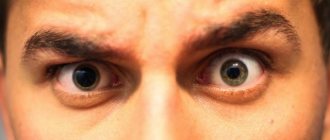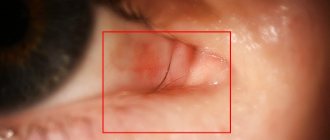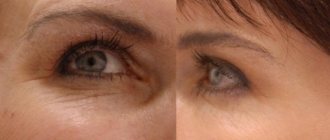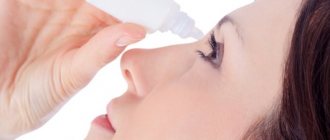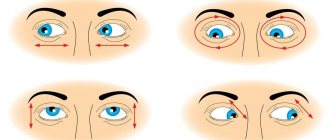Pupil dilation
is a process that allows more light to enter the eye. Doctors sometimes use drops to intentionally increase the diameter of a person's pupil and keep it dilated. This allows the doctor to examine the back, inner part of the eye to diagnose certain eye conditions.
When using eye drops, it takes up to 30 minutes to fully dilate the pupil. Dilation usually lasts from 4 to 24 hours. This amount of time varies widely as certain factors influence the duration of pupil dilation.
What does an eye examination for dilated pupils include?
A dilated eye examination is a medical examination in which a doctor checks the condition of the eyes and detects diseases in the early stages. Before starting the test, an ophthalmologist or optometrist administers pupil dilating drops. Dilatation (expansion) of the pupil takes effect within 20-30 minutes. However, people with blue or green eyes will have a pupil that dilates faster than people with brown eyes. If your pupils are dilated, your doctor may do several additional tests, such as:
- Pupil light reaction test: The doctor shines a small flashlight into the eyes to see how the pupils react to light.
- Ocular muscle function test: The doctor asks the patient to follow a moving object with his eyes. This allows the doctor to identify if there are problems with the muscles surrounding the eyes.
- Visual acuity test: The doctor asks the patient to read letters near and at a distance. The results show how clearly a person can see.
- Visual Field Test: A person looks straight ahead, reporting how well they can see objects in their periphery. This test evaluates a person's peripheral vision.
- Ocular tonometry: A special machine quickly blows a small amount of air into the eye. This method measures the pressure inside the eye.
Non-drug means of pupil constriction
There are various exercises to reduce pupil diameter. Examples:
- Carefully examine an object at arm's length, maybe even your own finger. The eye will tense up, which will cause the pupil to constrict.
- Move your gaze from top to bottom or from side to side. The head should be motionless.
- Circular rotation of the eyes clockwise or counterclockwise. The head should also not move.
Gymnastics to strengthen the eye muscles, gradually helping to narrow the pupils
These exercises help strengthen the eye muscles, so they can be performed for myopia, disruption of the oculomotor nerve and other neurological disorders. Frequency – 2 times a day, morning and evening, duration – 10 times for each movement. In case of chemical exposure, eye gymnastics will be ineffective.
How long does pupil dilation last?
While the eye exam may end fairly quickly, the dilatation itself will still be ongoing. During this time, a person may experience the following expansion effects:
- blurred vision
- sensitivity to bright light, such as sunlight
- difficulty focusing on nearby objects
The duration of pupil dilation can vary widely. The average duration of dilatation lasts from 4 to 24 hours. However, several different factors affect how long the pupil remains dilated. These include:
- Eye Color
: People with light eyes experience the effect of pupil dilation longer than people with dark eyes. - Age
: Children have a very strong eye focusing mechanism. Therefore, they require stronger medications to dilate their pupils. As a result, the child's pupils may remain dilated for longer than 24 hours. - Type of drug
: The drug the doctor uses to dilate affects how long the pupil remains dilated. For example, a doctor may use weaker drops to dilate the pupil when treating nearsightedness to limit side effects.
Normal pupil size
Reference! The eye's pupil is a hole in the center of the iris that can dilate and contract to control the amount of light allowed to the retina.
In a normal state and in the absence of ophthalmic pathologies, the size of the pupil can change an unlimited number of times a day, depending on the general condition of the person and the ambient lighting.
But in any case, there are average statistical indicators of pupil size, and in women this level is always higher than in men.
Average pupil size varies by age:
- in newborns this figure does not exceed three millimeters and practically does not change even with changes in lighting;
- at the age of 2-5 years, the pupil size is 4-5 millimeters;
- from 10 years to old age – 3-4 millimeters.
After the age of 50, there is a sharp decrease in the size of the pupil, which until the end of life can remain at the level of one and a half millimeters in diameter.
Side effects and how to deal with them
Pupil dilation can cause several side effects. The most immediate effect is a burning sensation, which usually occurs when the drops come into contact with the eyes. In some cases, doctors may use numbing drops beforehand to prevent the burning sensation. After the eye dilation drops take effect, a person may experience the following symptoms:
- blurred vision
- difficulty focusing on nearby objects
- photosensitivity
In very rare cases, a person may have an allergic reaction to the drops, which can lead to redness and swelling of the eyes. More severe allergic reactions may be caused by:
- dry mouth
- facial redness
- fever
- rapid pulse
There are some steps you need to take to deal with the effects of dilated pupils. These include:
- Wearing sunglasses: These will help protect your eyes, which are light sensitive due to dilated pupils.
- Avoiding close work: Reading and focusing on a computer screen may be difficult during pupil dilation.
Contraindications
Like any other pharmaceutical drugs, both miotics and mydriatics have their own contraindications and side effects.
Main contraindications:
- pregnancy and breastfeeding;
- the body's tendency to allergic reactions;
- bronchial asthma;
- chronic heart failure;
- cardiac ischemia;
- bleeding from the digestive tract;
- epileptic seizures;
- acute inflammation of organs in the abdominal cavity;
- iridocyclitis and iritis;
- hypertension;
- intestinal obstruction;
- stomach or duodenal ulcer;
- diabetes;
- spastic pain;
- state of shock.
Possible complication
Pupil dilation can sometimes lead to a temporary condition called cycloplegia
.
Cycloplegia
is paralysis of the eye muscle. For most people, cycloplegia only occurs when the drops begin to take effect. In rare cases, pupil dilation may cause cycloplegia within a few days. Although this condition can be alarming, it is temporary.
Having certain eye conditions can also complicate the effect of pupil dilation. Conditions such as lazy eye, glaucoma and cataracts can affect a person's vision. In some cases, these vision problems may get worse while the drops are in effect.
Side effects
Side effects may be:
- the occurrence of allergies;
- decrease in pressure;
- reduction in the diameter of the heart vessels;
- disturbance or slowing of heart rhythm;
- redness of the facial skin;
- the occurrence of shortness of breath;
- diarrhea;
- swelling and clouding of the cornea;
- lacrimation, as well as increased salivation;
- the occurrence of muscle cramps and tremors;
- dizziness;
- headache;
- sleep disturbance;
- increased sensitivity in the eye area.
So a self-selected drug can do more harm than good. Also, you cannot increase the dosage, because an overdose may occur, which will also negatively affect the body.
Folk remedies
Traditional methods can normalize the iris. For example, you can prepare one useful remedy. To do this, pour boiling water (one liter) into a glass of blueberries. To reduce the pupil, take a decoction of 60 milliliters at least four times a day. If this product is not available, then it can be replaced with blueberry-based tablets purchased at the pharmacy or the juice of these berries.
Raspberry leaves are also considered a good remedy. They should be boiled. As a result, you will get a decoction. It should be taken twice a day, 200 milliliters. Anise infusion not only helps to narrow the pupils, but also has a positive effect on blood circulation in the retina. Prepared in the same way as raspberry.
If the pupils have been constricted for a long time, what does this mean? This indicates that the thyroid gland is not active enough. Perhaps there is an inflammatory process in the brain or the pressure has increased sharply.
You can use bright light to make your pupils smaller. Any electric lamp will do for this, but natural light is much better. When you're outside, you just need to step out of the shadows. And if the sun is shining indoors and outside the window, then you should look in that direction for a few seconds.
When using natural bright light, you should never look directly at the sun, as such an action can negatively affect your vision and eyes.
If you deliberately constrict your pupils, this can lead to eye strain. Signs of this factor are painful sensations and twitching. In order not to harm the visual organs, it is necessary to stop these actions and give the eyes a rest for at least a couple of days.
Gymnastics for the eyes
To normalize the size of the pupillary openings, you can try doing gymnastics.
- To do this, focus your eye on some object that is high above your head, for example, the ceiling. Then make a sharp movement with your eyes downwards, looking at the farthest corner. This will count as one repetition. Perform these repetitions about ten times.
- Follow the clock hand of the clock and repeat its trajectory with your eye movements, and after completing a full circle, make the opposite movement. Do the same number of repetitions as in the first exercise.
- Take your gaze to one side. Move it from side to side. The number of repetitions is the same.
Gymnastics
To normalize the size of the pupils, you can do special gymnastics for the eyes.
First you need to focus your eyes on the ceiling, and then sharply move them to the far corner. You should repeat this movement 10 times, alternately looking up and down.
Make circular movements with your eyes the same number of times, first counterclockwise and then clockwise.
You also need to sharply shift your gaze to the left and then to the right.
You can try to constrict your pupils with your abdominal muscles. They need to be completely relaxed so that not even the slightest tension is felt.
Contrast compresses also have a great effect on pupil size. To do this, take two pieces of fabric. One is wetted in hot water, the second in cold water. They need to be changed every 10 seconds.
Another way to narrow your pupils is to alternate focusing your gaze on objects that are at different distances.
Directions for use and doses
If the doctor has not recommended a different regimen for instilling Atropine, use the standard treatment regimen: 1-2 drops into the affected eye. The drug is used up to three times a day, breaks between installations should be about 5-6 hours. For children, the drug is prescribed at a concentration of 0.5% or lower.
When instilling Atropine into a sore eye, you should press the inner lower corner of the eye with your finger. This will prevent the solution from going into the nasopharynx, which will reduce the likelihood of side effects.
Read further - the price of oxolinic ointment. Also instructions and reviews.
The article (link) contains instructions for use of Vigamox eye drops.
Reviews of artificial tear drops!
Features of prevention
To prevent the development of miosis, you should not prescribe any medications on your own. When working in hazardous industries, your eyes need to be protected with special means. If neurological problems arise, do not put off visiting a doctor.
In diabetes mellitus, pathologies of the eye organs can often be observed.
Constriction of the pupils is not always a sign of a serious illness. The functional change is not dangerous for humans and practically does not cause any inconvenience. But only an ophthalmologist can independently diagnose abnormalities. Having identified an anomaly, he will prescribe medications that will stop the development of the disease and eliminate the problem. In our other articles you can familiarize yourself with the causes and treatment of veils on the eyes and red spots on the eyes.
When the pupil dilates
In the Middle Ages, ladies dripped a tincture of poisonous belladonna containing alkaloids into their eyes. This action led to the dilation of the pupil and the appearance of shine. Large, black, deep and sparkling eyes were in fashion. The name of the plant translates as “beautiful woman.” The practice lost relevance after a while.
In the modern world, an increase in pupil diameter may be associated with illness or the effects of chemicals. Diseases and conditions in which the pupils are dilated:
In the last six points, both unilateral and bilateral expansion is possible, it depends on the size and area of the lesion.
Chemicals that open the pupils include:
If the release of hormones cannot be controlled, then the use of substances, alcohol and eye drops are conscious actions.
During an eye examination, the ophthalmologist needs to see the retina and fundus behind the pupil. This is important for pathologies such as:
